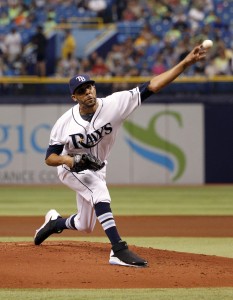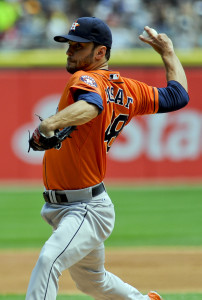The teams of the National League East were much less flashy than their American League brethren — as usual, perhaps — but nevertheless made several notable moves … or, in some cases, notable non-moves. Here’s what took place:
Braves
- Acquired lefty James Russell and utilityman Emilio Bonifacio from Cubs in exchange for Victor Caratini and cash
Marlins
- Acquired righty Jarred Cosart, infielder/outfielder Enrique Hernandez, and outfielder Austin Wates from Astros in exchange for third baseman Colin Moran, outfielder Jake Marisnick, righty Francis Martes, and a 2015 compensation draft pick
- Acquired lefty Donnie Joseph from Royals in exchange for cash
- Acquired righty Bryan Morris from Pirates in exchange for 2014 draft compensation pick
Mets
- No trades
Nationals
- Acquired infielder Asdrubal Cabrera and cash from Indians in exchange for infielder Zach Walters
Phillies
- No trades
Synopsis
Last year at this time, the Marlins were selling off what few veteran pieces they had for whatever they could get. Ricky Nolasco was the team’s big deadline piece, but unfortunately he didn’t really start pitching well until after he was playing for the Dodgers. But that was not the case this year. Still hanging around in the postseason pitcure even after losing stud righty Jose Fernandez, Miami went hard after Jon Lester before ultimately turning its sights to Houston.
The Fish got their arm in Cosart, and brought back additional value in Hernandez and Wates, but paid a big price. Marisnick was somewhat expendable given the team’s other young outfielders, but Moran was brought to Miami at a tall opportunity cost (6th overall draft pick; $3,516,500 bonus) and the team gave up a young power arm and future draft pick. The deal certainly helps the Marlins in the present — though just how much remains to be seen — and avoids a major sacrifice of future control. But if Marisnick and Moran reach their potential, and Cosart is not able to stick in the rotation, it could still hurt down the line.
On the other hand, as much as things change — the saying goes — the more they stay the same. Check out last year’s NL East recap if you don’t believe me. Braves and Nationals adding the final pieces for the stretch; Mets and Phillies standing pat at the deadline.
Sure, there were some differences. This time around, the Nats needed a more substantial addition after losing Ryan Zimmerman for some time. With Cleveland paying the rest of Cabrera’s salary, Washington agreed to ship out an MLB-ready middle infielder back to Cleveland. Though Walters is an interesting player — in large part due to his legitimate power bat up the middle — he has his warts and did not have a path to a job in DC. Cabrera will hold down the fort until Zimmerman returns (or until the end of the season, when the Nats will face some tough decisions).
Atlanta, meanwhile, once again added a lefty pen piece in the capable Russell, who could also forestall the necessity of such a move next year (he can be controlled through arbitration for 2015). This time around, the club also added a versatile utilityman in Emilio Bonifacio, who might conceivably see a fair bit of time at the positions (second, center, third) from which the club has at times received sub-optimal production. He will also be a nice pinch-running/hitting/fielding option, making for a sturdy bench piece for a contending club.
It may be easy to forget come deadline time, but there are still two more teams in the division. For the Mets, standing pat made plenty of sense. If nobody was going to take Bartolo Colon’s salary, then the organization may as well pay him to pitch in New York next year. Daniel Murphy is also under control and could be extended. And Chris Young just wasn’t bringing anything back at this point. In addition to holding onto veterans, the Mets did not appear to make a concerted effort to acquire younger, MLB-ready talent. As GM Sandy Alderson explains, he wasn’t interested in giving up young pitching at this time but could potentially look to cash in some prospect chips in the offseason. (Though it is tempting to wonder what New York might have been able to extract in a deal like that between the Marlins and Astros.)
Over in Philadelphia, justification for inaction was somewhat harder to come by. GM Ruben Amaro Jr. said that he was surprised that opposing teams did not come to him with more aggressive offers for the club’s available players, particularly as the team was willing to eat salary to facilitate a better return. But the fact is that none of the Phillies’ ready-to-move pieces were worth aggressive action. The list of names and contract complications (no-trade clauses, vesting options, massive buyouts, and the like) is already well-known; suffice to say that none of the assets that the Phillies shopped would have delivered the level of long-term value or short-term impact needed to motivate bidders.
Right now, there is simply no way for the team to get out from under its numerous long-term obligations to veterans while recouping any sort of prospect return. True, the Phillies could convince Chase Utley to waive the no-trade clause in his low-risk contract. They could decide to part with Cole Hamels for whatever the market will bear. But they’ve already shown they have no intention of doing those things.
Philadelphia seemingly wants to move the less desirable pieces and still get something back, but that is not going to happen. And that is why no deals were consummated. Other teams made more realistic assessments, as evidenced by the Yankees’ acquisition of several veterans (with at or above-market salaries) for a relative pittance of young talent. At several points in the last few seasons, players like Utley, Jimmy Rollins, and Cliff Lee could have been cashed in. Instead, they were supplemented by even older players brought in at open-market rates. It is now too late (for various reasons) to recoup any significant value for any of them, which the team’s inaction reflects.

